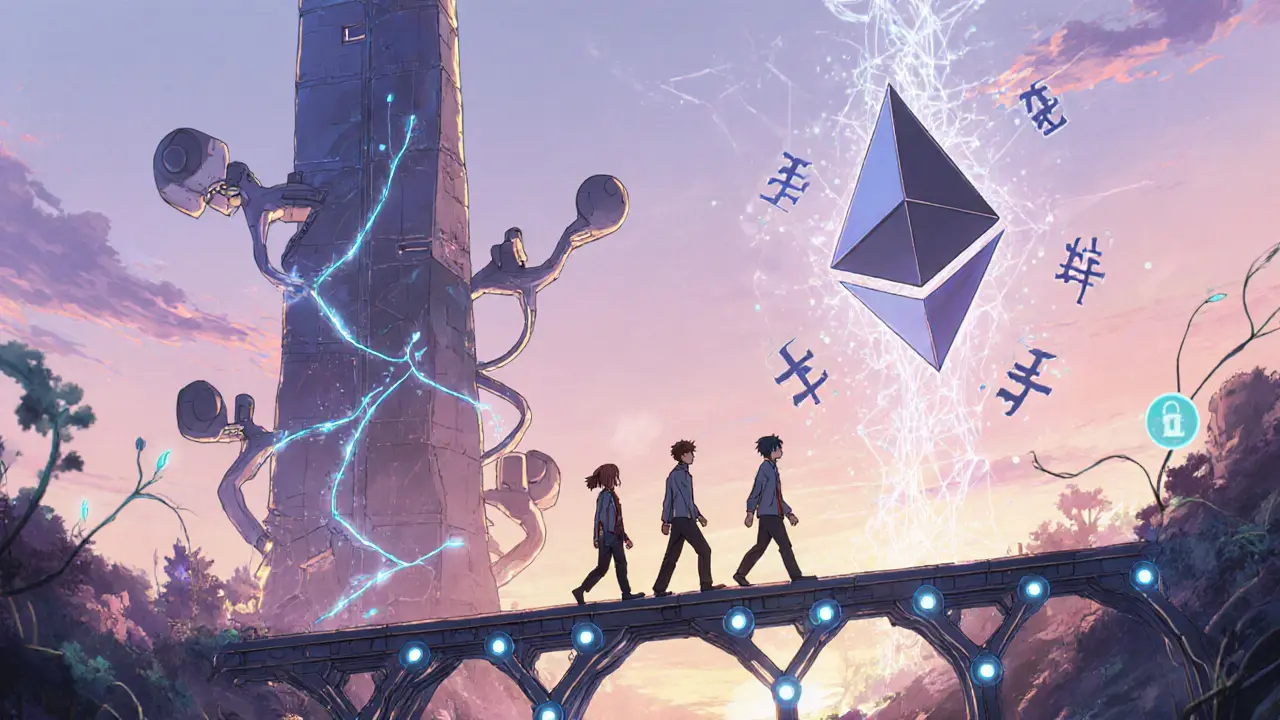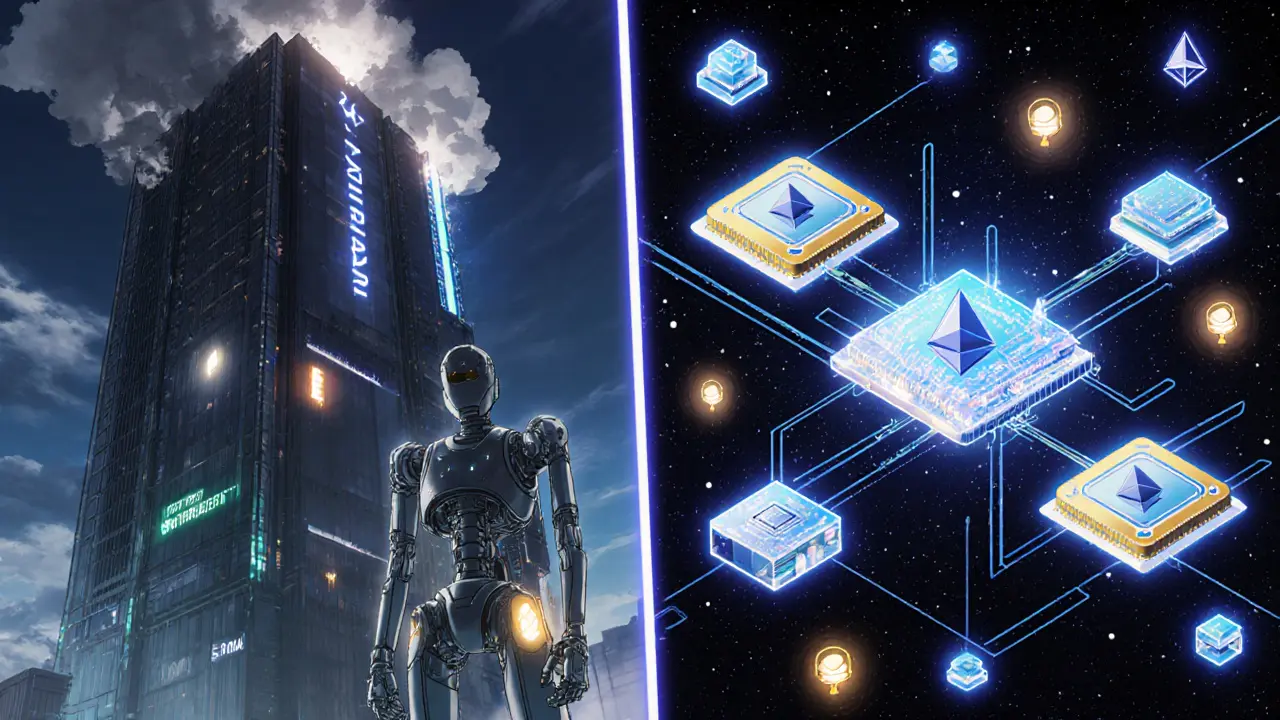When you send a crypto transaction, what’s really happening behind the scenes? Most people don’t think about it - but the answer shapes everything: how fast your transaction clears, how much it costs, and whether the network crashes when everyone tries to use it at once. That’s where blockchain architecture comes in. There are two main ways to build a blockchain: monolithic and modular. One tries to do everything in one place. The other splits tasks apart. And right now, the crypto world is split over which one is better.
What Is a Monolithic Blockchain?
A monolithic blockchain handles every single job on one layer. Think of it like a single factory where every worker does everything - assembling parts, inspecting quality, packing boxes, and shipping orders. Bitcoin and Solana are classic examples. Every node in the network validates transactions, runs smart contracts, reaches consensus, and stores the full history of the chain. This design is simple by nature. There’s no need to coordinate between different systems. Everything is built-in, tightly integrated, and secure because trust isn’t spread across multiple parts. Solana, for example, can process up to 65,000 transactions per second and settle them in 2-5 seconds. That’s why it became the go-to chain for NFT drops and high-frequency trading. During the 2021 Degenerate Ape Academy launch, Solana handled over 4,400 NFT mints in minutes - something Ethereum couldn’t touch at the time. But there’s a catch. That speed comes at a cost. To keep up, validators need serious hardware: 128GB of RAM, a 1.2TB NVMe drive, and a 1Gbps internet connection. That’s not something your average person can run on a laptop. As a result, Solana’s network is controlled by just 1,952 validators. Ethereum, by contrast, has over 811,000. That makes monolithic chains more vulnerable to centralization. And when things go wrong? They go very wrong. Solana had 19 outages in 2022 - totaling over 41 hours of downtime. One developer lost $250,000 in revenue during a single April 2023 outage.What Is a Modular Blockchain?
Modular blockchains break the job into pieces. Instead of one big factory, you have specialized teams: one handles transaction execution, another settles payments, a third ensures data is available, and a fourth runs consensus. Ethereum is leading this shift. Its core chain (Layer 1) now focuses mostly on security and data availability. All the heavy lifting of processing transactions happens on Layer 2 rollups like Arbitrum and Optimism. This approach lets each layer be optimized independently. Rollups can process thousands of transactions per second - Arbitrum hits 4,500 TPS - while Ethereum’s mainnet focuses on being a secure settlement layer. Data availability is getting better too. With the Dencun upgrade in January 2024, Ethereum introduced proto-danksharding, which will cut Layer 2 transaction costs by up to 90%. The trade-off? Complexity. Users now have to bridge assets between layers. Developers have to learn multiple tools - Solidity for Ethereum, Cairo for StarkNet, and rollup-specific frameworks. A 2023 ConsenSys survey found 68% of Ethereum users felt confused by bridging. And 73% of developers said they spent 30-40% of their time fixing cross-layer compatibility issues. But the security payoff is real. Ethereum’s total value locked in DeFi sits at $28 billion as of October 2023. That’s more than all other chains combined. And because the security of rollups is anchored to Ethereum’s strong consensus, they inherit its battle-tested reliability. No rollup has ever been hacked directly - the biggest losses happened on bridges, not the core chain.Performance Comparison: Speed, Cost, and Uptime
Here’s how the two stack up side by side:| Feature | Monolithic (Solana) | Modular (Ethereum + Rollups) |
|---|---|---|
| Transactions per second (TPS) | 65,000 | 15-30 (L1), up to 4,500 (Arbitrum) |
| Average transaction fee | $0.00025 | $0.10-$1.50 (L2), $1-$10+ during congestion |
| Finality time | 2-5 seconds | 1-7 days (optimistic), under 10 seconds (ZK-rollups) |
| Network uptime (2022) | 98.8% | 99.989% |
| Active validators | 1,952 | 811,784 |
| Hardware needed for validator | $15,000-$20,000 | $3,000-$5,000 (execution), plus rollup costs |
Monolithic chains win on raw speed and low fees. But modular chains win on reliability and decentralization. If you’re running a high-frequency trading bot, Solana’s speed is tempting. But if you’re locking up millions in DeFi, Ethereum’s security is non-negotiable.

Who Uses Which Architecture - and Why?
Use cases are splitting along clear lines. Gaming, NFTs, and social apps - where speed and low cost matter most - are dominated by monolithic chains. DappRadar shows 78% of gaming and NFT projects run on Solana, Avalanche, or similar chains. These platforms prioritize user experience: fast mints, instant trades, no bridges. Enterprise and DeFi? That’s where modular chains rule. DeFi Llama reports 89% of total value locked is on Ethereum-based rollups. Why? Because financial applications need strong guarantees. You can’t afford a hacked bridge or a chain that goes down during market volatility. Financial institutions like JPMorgan and BlackRock prefer modular designs because they can audit each layer separately - something the EU’s MiCA regulation actually encourages. Even consumer apps are starting to shift. While Solana dominates NFT launches, platforms like OpenSea now support multiple chains. Users aren’t tied to one anymore. And as rollup costs drop, even gaming apps are exploring Ethereum-based solutions for better long-term security.The Future: Hybrid Architectures Are Coming
The debate isn’t about which architecture wins - it’s about how they’ll merge. Solana’s Firedancer client, expected in Q2 2024, is adding modular components. It’s still a monolithic core, but now it has specialized processing units that handle specific tasks - like a factory hiring external experts for complex jobs. Meanwhile, Ethereum is becoming more modular by design. With danksharding, it’s turning into a data availability layer for dozens of rollups. Projects like Celestia and Avail are building standalone data availability layers that other chains can plug into. This isn’t just evolution - it’s a new category: the modular-monolithic hybrid. Industry experts are betting on convergence. CoinDesk’s September 2023 survey found 78% of respondents believe architectural boundaries will blur within 3-5 years. The winner won’t be monolithic or modular - it’ll be whatever lets you move fast, stay secure, and scale without sacrificing decentralization.
Which One Should You Choose?
If you’re a developer:- Build on Solana if you want speed, simple tooling, and are okay with occasional outages.
- Build on Ethereum rollups if you need long-term security, enterprise adoption, and don’t mind learning multiple stacks.
- Use Solana for daily NFT trading, gaming, or low-cost payments.
- Use Ethereum for DeFi, long-term holdings, or anything involving real money.
- Monolithic chains have higher growth potential in consumer apps but carry higher operational risk.
- Modular chains are slower to grow but have stronger moats - especially in finance and enterprise.
Frequently Asked Questions
Is Solana really faster than Ethereum?
Yes, Solana’s monolithic design allows it to process up to 65,000 transactions per second, while Ethereum’s base layer only handles 15-30 TPS. But Ethereum’s Layer 2 rollups like Arbitrum can reach 4,500 TPS - close to Solana’s speed - with far stronger security. Speed alone doesn’t tell the whole story.
Why do modular blockchains have more security?
Because they separate concerns. Ethereum’s mainnet, which handles consensus and data availability, is secured by over 800,000 validators. Rollups inherit that security. Even if a rollup gets compromised, the underlying chain remains intact. Monolithic chains like Solana rely on one set of validators - fewer than 2,000 - making them more vulnerable to centralization and coordinated attacks.
Are monolithic blockchains more centralized?
Yes. Running a Solana validator requires expensive hardware - $15,000-$20,000 worth - which limits participation to well-funded entities. Ethereum’s modular approach allows anyone to run a lightweight node, and its 811,784 active validators are spread globally. More participants mean less control by a few.
Do I need to learn new programming languages for modular blockchains?
Yes. Ethereum development requires Solidity for Layer 1, but rollups use different languages: Cairo for StarkNet, Rust for Optimism, or even ZK-SNARKs for ZK-rollups. That’s why the average learning curve for Ethereum developers is 12-16 weeks - nearly twice as long as Solana’s 6-8 weeks.
Will monolithic blockchains disappear?
No. They’ll thrive in areas where speed and simplicity matter most - gaming, social apps, and NFTs. But as scalability demands grow, even Solana is adding modular features. The future isn’t one architecture winning - it’s both evolving to borrow from each other.
Which is better for enterprise use?
Modular blockchains. Companies like JPMorgan, Deloitte, and IBM prefer Ethereum’s rollup ecosystem because it allows for compliance auditing at each layer. The EU’s MiCA regulation even treats modular components as separate legal entities, making them easier to regulate. Monolithic chains are harder to audit and more likely to trigger regulatory scrutiny.


15 Responses
Bro, Solana just got wiped out again 😭 19 outages in a year?! That’s not a blockchain, that’s a rollercoaster with no safety bars. Meanwhile Ethereum’s just chillin’ like a villain with 99.989% uptime. I’m out. 🚫💸
It’s not about which architecture wins-it’s about which one lets us sleep at night. Monolithic chains are like that one friend who runs a marathon in flip-flops: flashy, fast, but one wrong step and you’re in the ER. Modular? That’s the quiet person who builds a bridge with steel and soul. We don’t need speed-we need sanctity. 🕊️
The entire discourse is fundamentally flawed. You’re comparing apples to quantum entanglement. Monolithic systems optimize for throughput at the cost of ontological fragility, while modular architectures instantiate a distributed epistemology anchored in Byzantine fault tolerance at scale. Ethereum’s proto-danksharding isn’t an upgrade-it’s a paradigm shift in cryptographic sovereignty. Solana’s validator set? A feudal lordship disguised as decentralization. 🧠⚡
Y’all are overcomplicating this. If you’re trading NFTs at 3 a.m. and your transaction dies? That’s not tech-it’s trauma. Solana’s speed saves lives (and wallets). But if you’re locking in $10M in DeFi? Then yeah, go Ethereum. Use both. No shame. 🙌💎
Ethereum is just a bloated mess with 800k nodes and still can't handle a meme coin launch. Solana's down more than my ex's texts. Who cares about 'security' when your gas fee is $3? I'm using Solana and I don't care what you think. 🤷♂️🔥
I just want to say-this whole thread made me feel so seen. I’ve been trying to explain to my uncle why I don’t use Solana for my crypto savings, and now I’ve got the perfect analogy. Thank you for writing this. You’re not alone. 💛
Wait-so if Ethereum’s L1 only handles data availability, and rollups do execution, then technically the chain isn’t even ‘blockchain’ anymore? It’s more like a data highway with toll booths. Is that still decentralized if the toll operators are private firms?
In India, we say: ‘Don’t chase the fastest horse if the road is full of potholes.’ Solana’s fast, sure. But when it crashes, your NFT doesn’t just vanish-it vanishes with your reputation. Ethereum? Slow, but it remembers every transaction like a grandmother remembers your birthday. 🙏
i just wanna buy aape and chill why is this so hard
The table above is misleading. It compares Solana’s theoretical peak TPS with Arbitrum’s actual throughput. That’s like comparing a Ferrari’s top speed with a Prius’s city MPG. Also, ‘$0.00025’ fees are statistically irrelevant when 99% of users pay $0.01–$0.10 during congestion. The uptime metric is accurate, though. Ethereum’s reliability is unmatched.
The proliferation of modular architectures represents not merely an engineering evolution, but a civilizational recalibration toward institutional-grade cryptographic infrastructure. Solana’s monolithic paradigm, while aesthetically elegant, remains an artifact of the Web2 mindset-optimizing for velocity over verifiability. The regulatory frameworks emerging in the EU and US are already codifying this distinction. One is a marketplace; the other, a sovereign ledger.
I’ve been running a validator on Solana since 2021. It’s a beast. You need a whole room for the hardware, constant cooling, and someone watching it like a hawk. I’ve had to reboot it 17 times in the last year. Meanwhile, my Ethereum node? Runs on a Raspberry Pi I got from Best Buy. I plug it in, forget about it, and it just works. I don’t care how many TPS it does-I care that I’m not stressed every time I leave the house. And yeah, the fees on L2s are still a pain, but at least I know my money’s safe. I’ve lost more money to Solana outages than I’ve saved on gas. It’s not even close.
MODULAR WINS 🏆🔥 LET’S GOOOO! ETH IS THE FUTURE AND I’M LIVING IN IT 🚀💎 #danksharding #rollupsrule
I used to think Solana was the future until I lost $2k because a mint failed mid-drop. Now I use Ethereum for anything real and Solana for memes. It’s like having a Tesla for work and a bicycle for coffee runs. Different tools for different vibes. 🛵☕
For anyone new to this: start with Ethereum + MetaMask. Use Arbitrum or Base for cheap swaps. Save Solana for NFTs you don’t mind losing. And if you’re building something-ask yourself: ‘Will this still work if the network crashes tomorrow?’ If the answer isn’t ‘yes,’ go modular. You’ll thank yourself later. 💪